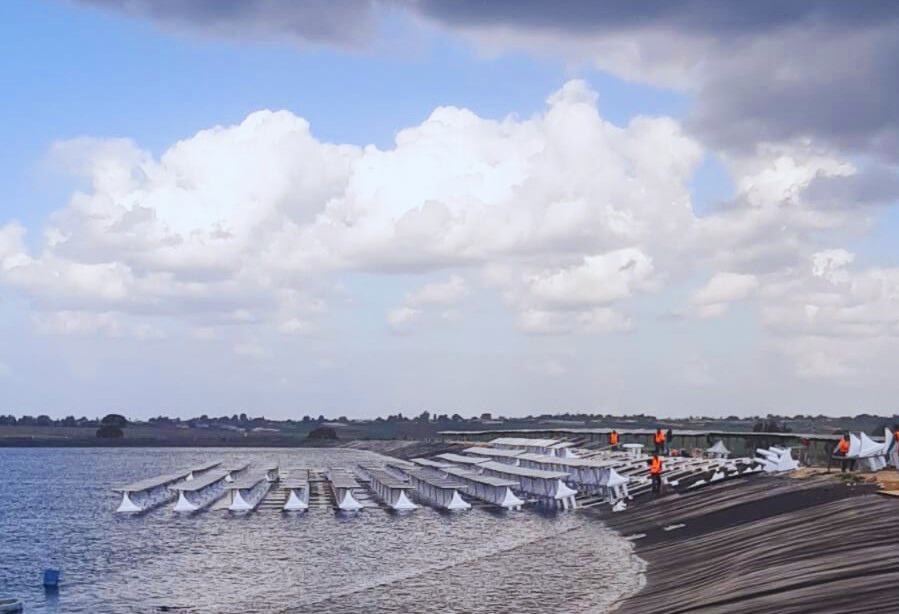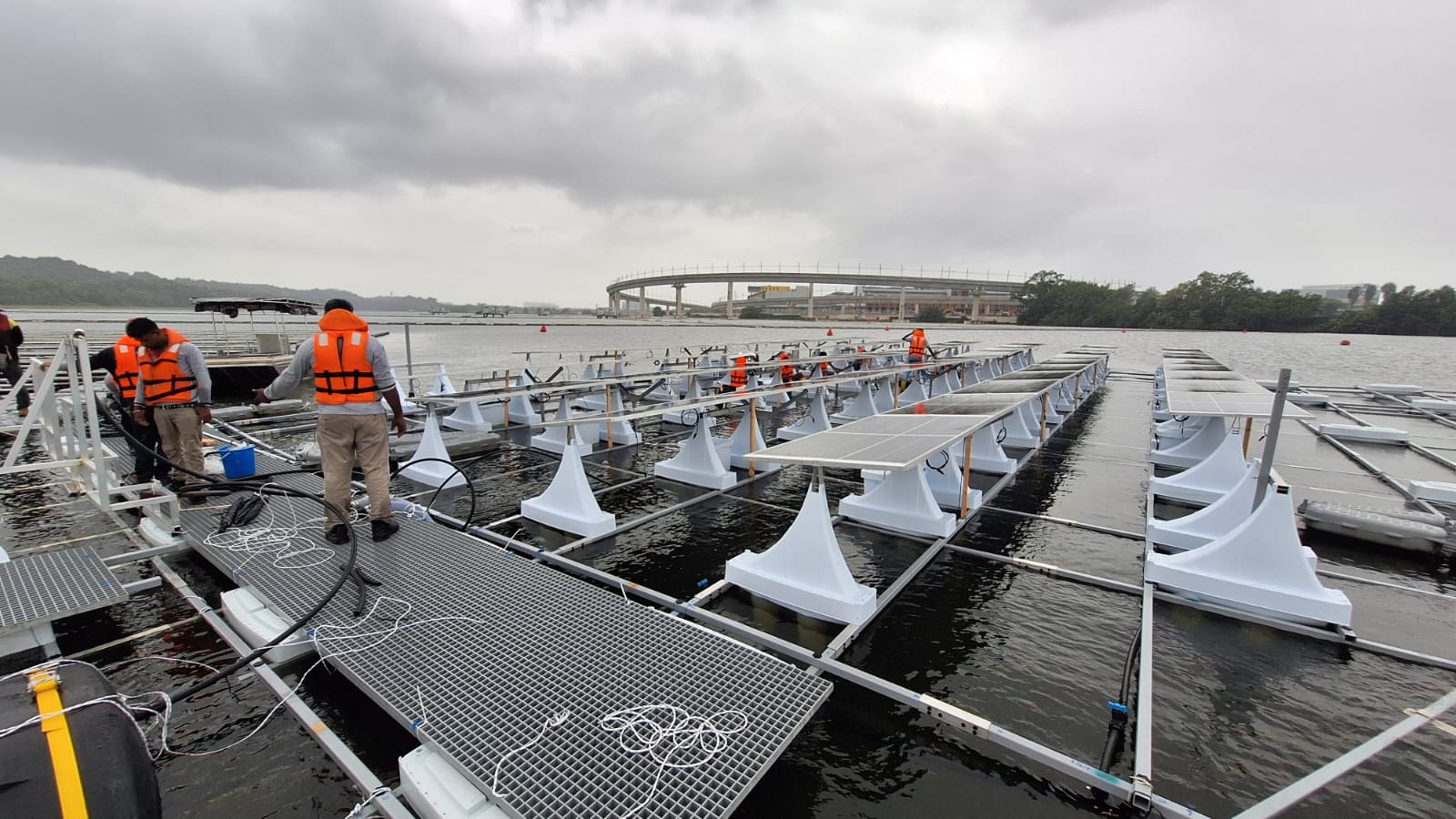Floating photovoltaic (FPV) systems represent a novel approach to solar energy generation, utilizing water bodies to install solar panels. A notable advantage of Xfloat’s FPV systems is the integration of solar trackers, which significantly augment their efficiency and performance. A crucial aspect that potential adopters of floating photovoltaic (FPV) systems should comprehend is the capability to optimize the DC/AC loading ratio to ensure consistent AC production.
Enhanced Energy Production
Optimal Sun Tracking: FPV tracker systems maximize efficiency by adjusting the orientation of the solar panels throughout the day to follow the sun’s trajectory. This optimization maximizes solar energy capture by maintaining an optimal angle relative to the sun, resulting in an increase of 18%-22% in energy production compared to fixed systems.
Consistent Energy Yield: Trackers facilitate more consistent energy production throughout the day. This steady energy output enables the inverter to operate closer to its optimal capacity for extended periods of the day, surpassing the capabilities of any fixed tilt system. Consequently, the overall efficiency of the system is enhanced.
Improved DC/AC Ratio
Lower DC/AC Ratio: Tracker systems provide more evenly distributed energy generation throughout the day. In contrast to fixed-tilt systems, which exhibit a pronounced midday peak for a limited duration, trackers attain their peak earlier in the morning and maintain it throughout the afternoon. Most photovoltaic (PV) systems are designed to maintain a consistent AC power output for an extended period. Achieving this necessitates a substantially larger DC installation for fixed-tilt systems compared to tracker systems. For instance, a typical tracker system may require a DC-to-AC ratio of 1.15 to 1.2 (kWp/kWac), whereas a fixed-tilt system would necessitate a higher ratio of 1.35 to 1.5 to attain the same level of AC production.
Reduced Clipping Losses: Trackers mitigate clipping losses, which occur when the inverter cannot convert all generated DC power to AC power. The even distribution of power generation prevents excessive peaks, minimizing energy wastage and enhancing the inverter’s efficiency.
Improved Storage System Efficiencies: A steady generation curve with a low variability between AC and DC generation typically leads to more efficient storage system sizing and adjustments. This optimization improves both initial economics and long-term operational and economic requirements.
Read more here: Understanding DC/AC Ratio.
Material Efficiency:
Fewer Panels Required: Trackers enhance energy output per unit area, necessitating fewer solar panels to achieve the same energy output as fixed systems. This reduction in panel count translates to lower material costs and a smaller environmental and operational footprint for installation. Fixed systems already benefit from utilizing water surfaces, avoiding the use of valuable land. Adding trackers to fixed systems further enhances space utilization, generating more energy per unit area of water surface.
Water Quality: The smaller water surface coverage of trackers compared to fixed systems allows for higher water aeration and sunlight exposure. This, in turn, provides several operational benefits and presents opportunities for PV project development. In most territories, PV installations on water bodies are subject to specific cover ratios (typically ~30%). The combination of improved DC/AC ratio and enhanced water quality achievable through trackers may enable substantial project sizing and cost reductions.
**Enhanced Revenue Generation:** FPV systems equipped with trackers can generate more energy, particularly during peak demand periods, thereby increasing revenue. This is particularly advantageous in markets with time-of-use pricing, as the improved efficiency and consistent energy production maximize the financial return on investment.
Extended Inverter Lifespan: Operating at a lower DC/AC ratio reduces the strain on the inverter, leading to lower operating temperatures and diminished wear and tear. This extended lifespan reduces maintenance costs and enhances overall system reliability.
Long-Term Financial and Operational Savings:
The utilization of trackers in FPV systems allows for the installation of lower DC capacity while still achieving the desired energy output. This reduction in installed capacity directly translates to substantial long-term operational and maintenance (O&M) savings. O&M costs for PV projects are typically priced per kWp. The substantial reduction in installed DC capacity for an equal AC generation significantly reduces annual operational expenses and the associated profitability of the project. This not only lowers costs for routine labor and materials required for inspections, cleaning, and preventative maintenance, but also minimizes the likelihood of equipment failure over time.
Conclusion:
Integrating FPV tracker systems maximizes efficiency, enhances performance, and optimizes resource utilization for utility-scale solar projects. Key benefits include improved DC/AC loading ratios, enhanced energy production, increased material efficiency, and better project economics. While there may be higher initial and maintenance costs per kWp associated with trackers, the initial advantages in project sizing and the long-term benefits, such as higher energy yields, reduced operating costs per AC kW generated, and enhanced financial returns, make FPV Tracker systems a compelling choice for maximizing efficiency, performance, resource utilization, and overall project economies for all stakeholders involved in utility-scale solar projects.



